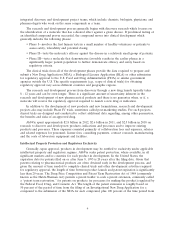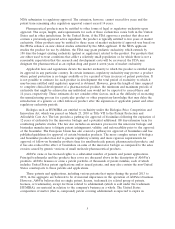AbbVie 2012 Annual Report Download - page 20
Download and view the complete annual report
Please find page 20 of the 2012 AbbVie annual report below. You can navigate through the pages in the report by either clicking on the pages listed below, or by using the keyword search tool below to find specific information within the annual report.from time to time for legislation to further encourage the early and rapid approval of generic drugs.
Any such proposals that are enacted into law could worsen the effect of generic competition.
AbbVie’s principal patents and trademarks are described in greater detail in Item 1, ‘‘Business—
Intellectual Property Protection and Regulatory Exclusivity’’ and Item 7, ‘‘Management’s Discussion and
Analysis of Financial Condition and Results of Operations—Results of Operations,’’ and litigation
regarding these patents is described in Item 3, ‘‘Legal Proceedings.’’ The U.S. composition of matter
patent for HUMIRA, which is AbbVie’s largest selling product and had worldwide sales of
approximately $9.3 billion in 2012, is expected to expire in December 2016, and the equivalent
European Union patent is expected to expire in the majority of EU countries in April 2018. Because
HUMIRA is a biologic and biologics cannot be readily substituted, it is uncertain what impact the loss
of patent protection would have on the sales of HUMIRA.
AbbVie’s major products could lose patent protection earlier than expected, which could adversely affect
AbbVie’s future revenues and operating income.
Third parties or government authorities may challenge or seek to invalidate or circumvent
AbbVie’s patents and patent applications. For example, manufacturers of generic pharmaceutical
products file, and may continue to file, Abbreviated New Drug Applications (ANDAs) with the United
States Food and Drug Administration (FDA) seeking to market generic forms of AbbVie’s products
prior to the expiration of relevant patents owned or licensed by AbbVie by asserting that the patents
are invalid, unenforceable and/or not infringed. For example, certain companies have filed ANDAs
seeking approval to market generic versions of fenofibric acid capsules (TRILIPIX) and niacin
extended release tablets (Niaspan). These companies have asserted that the AbbVie patents covering
these products are invalid, unenforceable, and/or not infringed by their respective products. AbbVie has
entered into settlement agreements resolving substantially all of these challenges. For a description of
other material pending challenges, please refer to Item 3, ‘‘Legal Proceedings.’’
Although most of the challenges to AbbVie’s intellectual property have come from other
businesses, governments may also challenge intellectual property rights. For example, court decisions
and potential legislation relating to patents, such as legislation regarding biosimilars, and other
regulatory initiatives may result in further erosion of intellectual property protection. In addition,
certain governments outside the United States have indicated that compulsory licenses to patents may
be sought to further their domestic policies or on the basis of national emergencies, such as HIV/AIDS.
If triggered, compulsory licenses could diminish or eliminate sales and profits from those jurisdictions
and negatively affect AbbVie’s results of operations.
AbbVie normally responds to challenges by vigorously defending its patents, including by filing
patent infringement lawsuits. Patent litigation and other challenges to AbbVie’s patents are costly and
unpredictable and may deprive AbbVie of market exclusivity for a patented product. To the extent
AbbVie’s intellectual property is successfully challenged or circumvented or to the extent such
intellectual property does not allow AbbVie to compete effectively, AbbVie’s business will suffer. To the
extent that countries do not enforce AbbVie’s intellectual property rights or require compulsory
licensing of AbbVie’s intellectual property, AbbVie’s future revenues and operating income will be
reduced.
A third party’s intellectual property may prevent AbbVie from selling its products or have a material adverse
effect on AbbVie’s future profitability and financial condition.
Third parties may claim that an AbbVie product infringes upon their intellectual property.
Resolving an intellectual property infringement claim can be costly and time consuming and may
require AbbVie to enter into license agreements. AbbVie cannot guarantee that it would be able to
obtain license agreements on commercially reasonable terms. A successful claim of patent or other
14
























